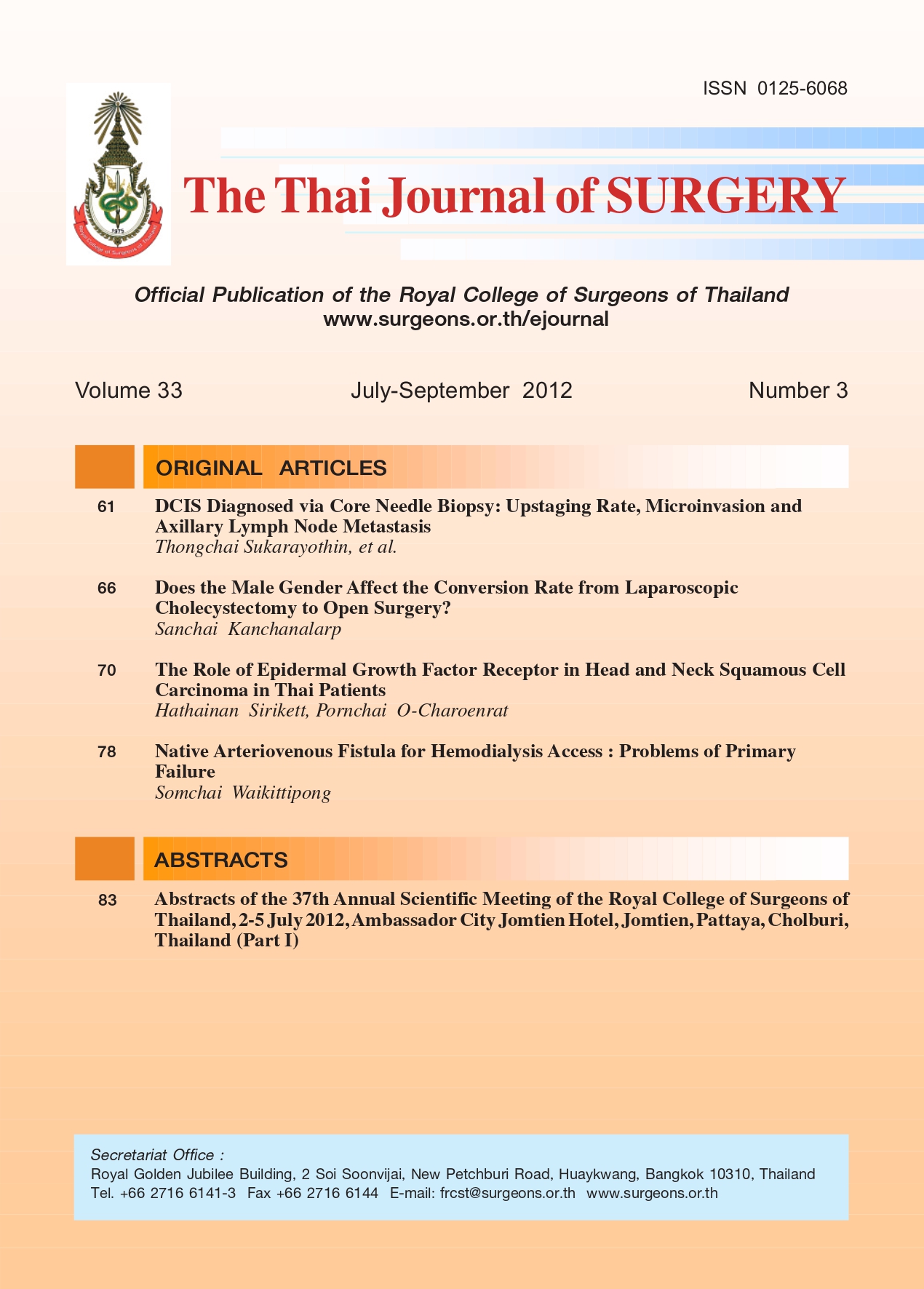DCIS Diagnosed via Core Needle Biopsy: Upstaging Rate, Microinvasion and Axillary Lymph Node Metastasis
Keywords:
ductal carcinoma in situ, microinvasion, upstaging, prediction, axillary lymph node metastasisAbstract
Objective: To determine the upstaging rate of core needle-diagnosed ductal carcinoma in situ (DCIS) toinvasive breast cancer, as well as to identify risk factors for upstaging; and to relate DCIS with or without
microinvasion to the rate of axillary lymph node metastasis.
Methods: Records of breast cancer patients with core needle biopsy (CNB) diagnosis of DCIS with or
without microinvasion who subsequently underwent definitive surgery during the years 2008 to 2010 were
reviewed. Data on clinical findings, mammographic findings, CNB findings, breast surgical procedures, axillary
lymph node procedures, nodal metastasis, and final pathological diagnosis were collected. Upstaging rates were
calculated and compared between DCIS groups and attempts were made to identify risk factors for upstaging
and axillary lymph node metastasis.
Results: CNB-diagnosed pure DCIS were upstaged to any invasive breast cancer in 42% (25/59) of
patients, and to macro-invasive cancer only in 19% (11/59). DCIS with microinvasion was upstaged to macroinvasive
cancer in 34% (10/29). No risk factors were identified which could predict upstaging. Final diagnoses
of pure DCIS, DCIS with microinvasion and macro-invasive breast cancer were associated with axillary lymph
node metastasis rates of 0 (0/33), 5% (1/20) and 24% (5/21), respectively. No set of risk factors could identify
patients with a high likelihood of axillary metastasis.
Conclusion: CNB-diagnosed DCIS with or without microinvasion had a relatively high upstaging rate. No
high-risk group for invasive cancer or axillary lymph node involvement could be identified.
References
Lertsithichai P. Factors associated with upstaging of ductal
carcinoma in situ diagnosed by core needle biopsy using
image guidance. Jpn J Radiol 2011;29:547-53.
2. Yen TWF, Hunt KK, Ross MI, Mirza NQ, Babiera GV, Meric-
Bernstam F, et al. Predictors of invasive breast cancer in
patients with an initial diagnosis of ductal carcinoma in situ:
a guide to selective use of sentinel lymph node biopsy in
management of ductal carcinoma in situ. J Am Coll Surg
2005;200:516-26.
3. Kurniawan ED, Rose A, Mou A, Buchanan M, Collins JP,
Wong MH, et al. Risk factors for invasive breast cancer when
core needle biopsy shows ductal carcinoma in situ. Arch
Surg 2010;145:1098-104.
4. Huo L, Sneige N, Hunt KK, Albarracin CT, Lopez A, Resetkova
E. Predictors of invasion in patients with core-needle biopsydiagnosed
ductal carcinoma in situ and recommendations
for a selective approach to sentinel lymph node biopsy in
ductal carcinoma in situ. Cancer 2006;107:1760-8.
5. Hung WK, Ying M, Chan M, Mak KL, Chan LK. The impact of
sentinel lymph node biopsy in patients with a core biopsy
diagnosis of ductal carcinoma in situ. Breast Cancer
2010;17:276-80.
6. Goyal A, Douglas-Jones A, Monypenny I, Sweetland H,
Stevens G, Mansel RE. Is there a role of sentinel lymph node
biopsy in ductal carcinoma in situ?: analysis of 587 cases.
Breast Cancer Res Treat 2006;98:311-4.
7. Rutstein LA, Johnson RR, Poller WR, Dabbs D, Groblewski J,
Rakitt T, et al. Predictors of residual invasive disease after
core needle biopsy diagnosis of ductal carcinoma in situ.
Breast J 2007;13:251-7.
8. Yew M, Chan P, Lim S. Predictors of invasive breast cancer
in ductal carcinoma in situ initially diagnosed by core biopsy.
Asian J Surg 2010;33:76-82.
9. National Comprehensive Cancer Network. Breast Cancer.
Version 2.2011. NCCN Clinical Practice Guidelines in
Oncology; 2011.
10. De Mascarel I, MacGrogan G, Mathoulin-Pelissier S,
Soubeyran I, Picot V, Coindre JM. Breast ductal carcinoma
in situ with microinvasion: a definition supported by a longterm
study of 1248 serially sectioned ductal carcinomas.
Cancer 2002;94:2134-42.
11. Pimiero JM, Lee C, Esposito NN, Kiluk JV, Khakpour N, Bradford
Carter W, et al. Role of axillary staging in women diagnosed
with ductal carcinoma in situ with microinvasion. J Oncol
Pract 2011;7:309-13.
12. Wiratkapun C, Treesit T, Wibulpolprasert B, Lertsithichai P.
Diagnostic accuracy of ultrasonography-guided core
needle biopsy for breast lesions. Singapore Med J 2012;53:
40-5.
13. Krag DN, Anderson SJ, Julian TB, Brown AM, Harlow SP,
Costantino JP, et al. Sentinel-lymph-node dissection
compared with axillary-lymph-node dissection in clinically
node-negative patients with breast cancer: overall survival
findings from the NSABP B-32 randomized phase 3 trial.
Lancet Oncol 2010;11:927-33.
14. Veronesi U, Viale G, Paganelli G, Zurrida S, Luini A, Galimberti
V, et al. Sentinel Lymph node biopsy in breast cancer: tenyear
results of a randomized controlled study. Ann Surg
2010;251:595-600.
15. Giuliano AE, Hunt KK, Ballman KV, Beitsch PD, Whitworth PW,
Blumencranz PW, et al. Axillary dissection versus no axillary
dissection in women with invasive breast cancer and sentinel
lymph node metastasis: a randomized clinical trial. JAMA
2011;305:569-75.
Downloads
Published
How to Cite
Issue
Section
License
Articles must be contributed solely to The Thai Journal of Surgery and when published become the property of the Royal College of Surgeons of Thailand. The Royal College of Surgeons of Thailand reserves copyright on all published materials and such materials may not be reproduced in any form without the written permission.



